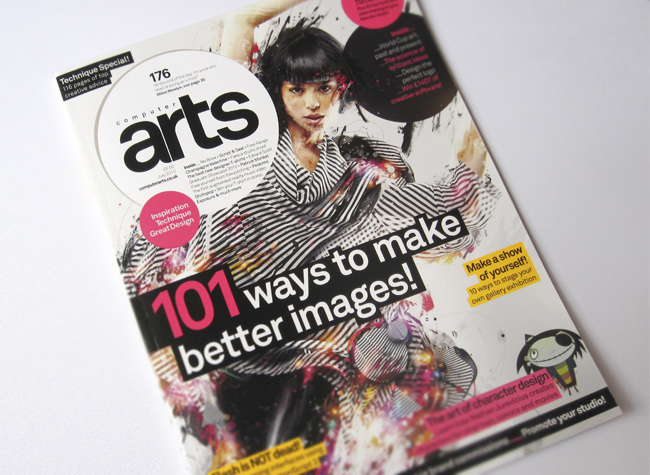Im also happy to be doing more work for the Telegraph magazine, doing illustrations for the fashion supplement. Ive also just finished a book cover for Little Brown Books, the UK edition of Kelly Armstrong's 'Gathering'. Hopefully i will be able to post them up soon.
For the July issue of Computer Arts magazine, they ran a series of articles for the 101 ways to make better images feature. I was kindly asked to provide 10 tips for the 'Brushes' section. If you havent seen the magazine heres the cover and my tips (theyre worded a lot better in the actual article!)

Get a Tablet!
To fully make use of the brushes in the major applications you really need a tablet. Once one is hooked up all the various brush options like pressure sensitivity, opacity, color dynamics, shape and scattering all become accessible and it also allows you to create work in a more intuitive way.
Rotate brushes
Its often an overlooked ability in the brush presets, but simply changing the rotation of a brush can produce some dramatic effects and is a feature worth playing around with if youre looking for something new. Obviously far more effective with brushes other than a basic circle tip!
Make custom brushes
It’s a lot easier than people expect. Most applications like Photoshop, Painter and Illustrator give you the ability to quickly make a new brush preset, fine tune the opacity, stroke, pressure and then save it for further use. Textures, marks from other brushes, photographs- all can be made into a new brush to breathe life into your work.
Download custom brushes
If you feel unsure about the process of creating your own or are pushed for time, there is a bunch of sites dedicated to sharing brushes that others have created. Most are free for personal or commercial use but some do require a credit so check what you download. Most brush repositories enable you to search for what youre after using basic filtering so it can be a quick way of finding a new effect.
Blending
For more realistic painting your digital paint can be blended together to produce soft transitions of colour. Corel Painter has the largest selection of brushes that replicate traditional media, blending paint in possibly the most realistic fashion. Photoshop 5 has introduced some new bristle brushes that accomplish a similar effect, in older versions using the smudge tool with a low opacity can also be used.
Brush Cursor
Most of the time the brush cursor is set by default to the standard outline of the brush tip which changes size as you increase or decrease the brush size. For the most part this is a fine way to paint but occasionally for detailed work or when youre zoomed in this display of the brush can get in the way. Temporarily switch over to the cross-hairs of the precise cursor by hitting the Caps lock on.
Add a layer style
When painting on layers your brush strokes can be given an extra dimension by adding a layer style. Simple brush marks can be given a variety of effects that can remain editable throughout your work-flow.
Default brushes
Its easy to forget that applications like Photoshop, Painter and Illustrator all come with brush libraries that have been created as a default toolset. Basic round head, soft, calligraphic, natural, wet and dry brushes are all useful and in many cases all you really need for many jobs.
Ditch the dodge and burn tools
Many creatives use the dodge and burn tools, most with subtlety, a few like a sledgehammer. Instead of jumping straight to those tools try the brush but change its mode to color dodge or color burn. It works best on a very low opacity and flow and instead of using a color to paint which can have some undesirable effects try using a mid range- dark gray.
Manage your brushes
Many people are so busy downloading or creating custom brushes they don’t realize that their brush library has become a ram sucking nightmare. Try to keep a default brush library that has a few of your most used brush types and either delete or create new brush libraries for the others. Name the library files in a way that will enable you to swap libraries in and out with ease for the job you are working on. Eg. Fabric textures.abr, foliage.abr, sketching brushes.abr.
-
Obviously theres a lot of other creatives talking about a variety of other subjects, certainly worth a look if youre at the news stand!
Im also in the process of sorting out the mostlywanted shop. Im going to be able to direct buyers to places where my work is currently for sale and also be putting out limited editions myself. If you would like to know when the shop goes live (and it may be a little while yet!) please pop over to the mostlywanted.com/shop page and register your email address where you will be added to a simple mailing list. You wont get anything else from me other than a single mail to let you know the shop is running- i wont be bombarding you with junk!

No comments:
Post a Comment